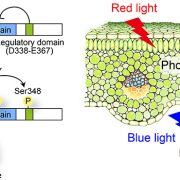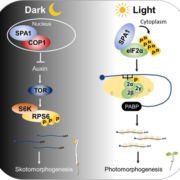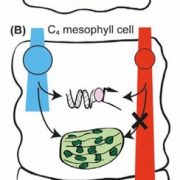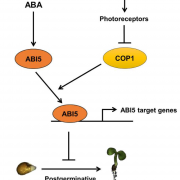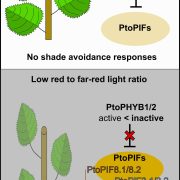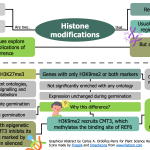A novel GUN1-independent retrograde signaling pathway represses photomorphogenesis (Plant Physiol.)
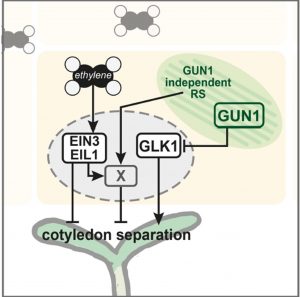 Seedlings emerging in light undergo photomorphogenic development, forming short hypocotyls and green, fully opened cotyledons. Disruption of chloroplast development by drugs such as lincomycin induces retrograde signals (RS) that inhibit photomorphogenesis. The retrograde signaling pathway has been known to act primarily through the chloroplast-localized master regulator protein GENOMES UNCOUPLED1 (GUN1). Now, Gommers et al. reveals the existence of a novel GUN1-independent pathway through which the retrograde signals induced by lincomycin inhibit cotyledon opening in light. This pathway relies on ethylene signaling that suppresses photomorphogenesis in seedlings. RS and ethylene signaling pathways converge at an unknown point downstream of the ethylene signaling transcription factors EIN3/EIL1 and co-induces a set of genes that are responsible for the inhibition of photomorphogenesis. These genes are distinct from the downstream genes of the light signaling network mediated by phytochromes and PIFs. The identity of the retrograde signal that is responsible for this novel pathway remains unknown. The authors speculate that it could be a known plastid-derived molecule like ROS, MecPP, PAP etc., or even a completely new signaling molecule that awaits discovery. (Summary by Yadukrishnan Premachandran @yadukrishprem) Plant Physiol. 10.1093/plphys/kiaa015
Seedlings emerging in light undergo photomorphogenic development, forming short hypocotyls and green, fully opened cotyledons. Disruption of chloroplast development by drugs such as lincomycin induces retrograde signals (RS) that inhibit photomorphogenesis. The retrograde signaling pathway has been known to act primarily through the chloroplast-localized master regulator protein GENOMES UNCOUPLED1 (GUN1). Now, Gommers et al. reveals the existence of a novel GUN1-independent pathway through which the retrograde signals induced by lincomycin inhibit cotyledon opening in light. This pathway relies on ethylene signaling that suppresses photomorphogenesis in seedlings. RS and ethylene signaling pathways converge at an unknown point downstream of the ethylene signaling transcription factors EIN3/EIL1 and co-induces a set of genes that are responsible for the inhibition of photomorphogenesis. These genes are distinct from the downstream genes of the light signaling network mediated by phytochromes and PIFs. The identity of the retrograde signal that is responsible for this novel pathway remains unknown. The authors speculate that it could be a known plastid-derived molecule like ROS, MecPP, PAP etc., or even a completely new signaling molecule that awaits discovery. (Summary by Yadukrishnan Premachandran @yadukrishprem) Plant Physiol. 10.1093/plphys/kiaa015


